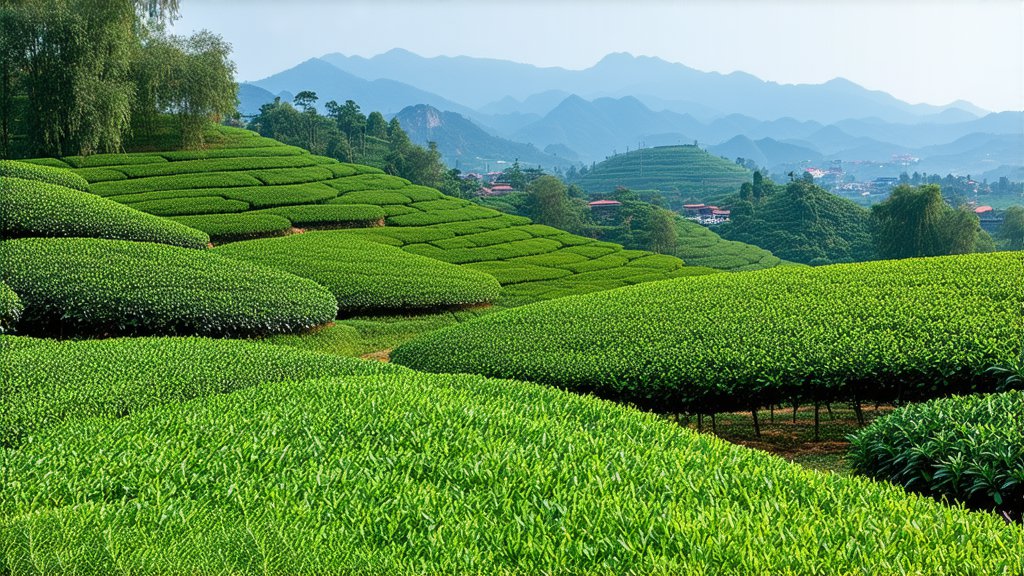
In the vast and diverse landscape of Chinese tea culture, few varieties have captivated tea enthusiasts quite like Tieguanyin, an exquisite oolong tea hailing from the mountainous regions of Anxi County in Fujian Province. With its rich history, unique cultivation practices, and intricate processing methods, Tieguanyin stands as a testament to the artistry and tradition that define Chinese tea making. This article embarks on a journey through the origins, varieties, production process, and art of appreciating this remarkable tea.
A Glimpse into History
Tieguanyin, often referred to as the "Iron Goddess of Mercy," traces its lineage back to the Ming Dynasty (1368-1644), though its popularity surged during the Qing Dynasty. Legend has it that the tea was discovered by a poor farmer named Wei Yin who found an ancient wild tea bush on a cliffside. He propagated the plant, which eventually gained recognition for its exceptional quality and unique flavor profile. Over time, Tieguanyin became not just a beverage but a symbol of prestige and refinement, enjoyed by emperors and common folk alike.
Varieties of Tieguanyin
Tieguanyin encompasses various sub-varieties, each with its distinct characteristics influenced by factors such as altitude, soil composition, and climatic conditions. Among the most renowned are:
- Xiang Pian (Fragrant Variety): Known for its floral aroma and smooth taste.
- Dan Cui (Single Cultivar): Prized for its high concentration of natural fragrances.
- Shui Xiang (Water Fragrance): Characterized by a sweet, fruity scent reminiscent of ripe peaches.
- Mao Xie (Downy Hair): Distinguished by its fine, downy leaves and a flavor profile that combines sweetness with a hint of bitterness.
- Carbonized (Huo Xiang): A roasted variant known for its smoky aroma and deeper flavor profile.
The Art of Crafting Tieguanyin
The production of Tieguanyin is a meticulous process that requires both skill and patience. It begins with careful selection of the finest leaves from mature tea bushes, typically grown at elevations between 300 and 1,000 meters above sea level. The harvest usually takes place in spring or autumn when the leaves are at their freshest.
Once harvested, the leaves undergo several stages of processing:
- Withering: Freshly picked leaves are spread out under the sun or indoors to reduce moisture content and initiate fermentation.
- Tossing & Turning: Leaves are tossed repeatedly to ensure even withering and to facilitate the development of complex flavors.
- Fixation: The leaves are briefly heated in a wok or over hot air to halt oxidation and preserve the desired level of oxidation.
- Rolling: The fixed leaves are rolled to form tight spirals, enhancing the extraction of flavor during brewing.
- Oxidation: The rolled leaves are allowed to oxidize further, a process carefully controlled to achieve the signature balance of aroma and flavor.
- Roasting: Depending on the desired outcome, some varieties may be lightly roasted to enhance their aroma or more heavily roasted for a smokier profile.
- Sorting & Packaging: Finally, the finished tea is sorted by size and quality before being packaged for distribution.
Appreciating Tieguanyin: The Tea Tasting Experience
To truly appreciate Tieguanyin, one must engage in the traditional Chinese tea ceremony, which emphasizes mindfulness, respect for nature, and the harmony between man and environment. Here's a guide to experiencing this tea at its best:
- Preparation: Use a Yixing clay teapot or a Gaiwan (a lidded bowl) made of porcelain or glass to allow for visual appreciation of the leaves unfurling. Boil water to approximately 90°C (194°F) for optimal extraction.
- Rinsing: Rinse the teapot and cups with hot water to warm them up and remove any residues. Place about 5 grams of Tieguanyin per 150ml of water ratio into the pot.
- Steeping: Pour hot water over the leaves and let them steep for about 30 seconds for the first infusion. Subsequent infusions can be extended gradually, as the leaves open up and reveal deeper flavors.
- Observing: Observe the color of the liquor, which should range from pale yellow to golden depending on the variety and steeping time.
- Smelling: Inhale the aroma from the cup or teapot before taking a sip. Note the subtle changes in fragrance with each subsequent infusion.
- Tasting: Sip slowly, allowing the tea to coat your palate. Pay attention to the balance between sweetness, bitterness, and astringency, as well as the lasting finish.
- Repeat: Tieguanyin can be steeped multiple times, each infusion revealing new dimensions of flavor and aroma.
Conclusion
Tieguanyin represents more than just a tea; it embodies centuries of Chinese cultural heritage, embodying the philosophy of harmony between humanity and nature. Its complex flavors and aromas invite exploration, making every cup a journey of discovery. Whether you're a seasoned connoisseur or a curious beginner, delving into the world of Tieguanyin promises an enriching experience that transcends the boundaries of time and space, connecting us to the ancient wisdom of tea making.